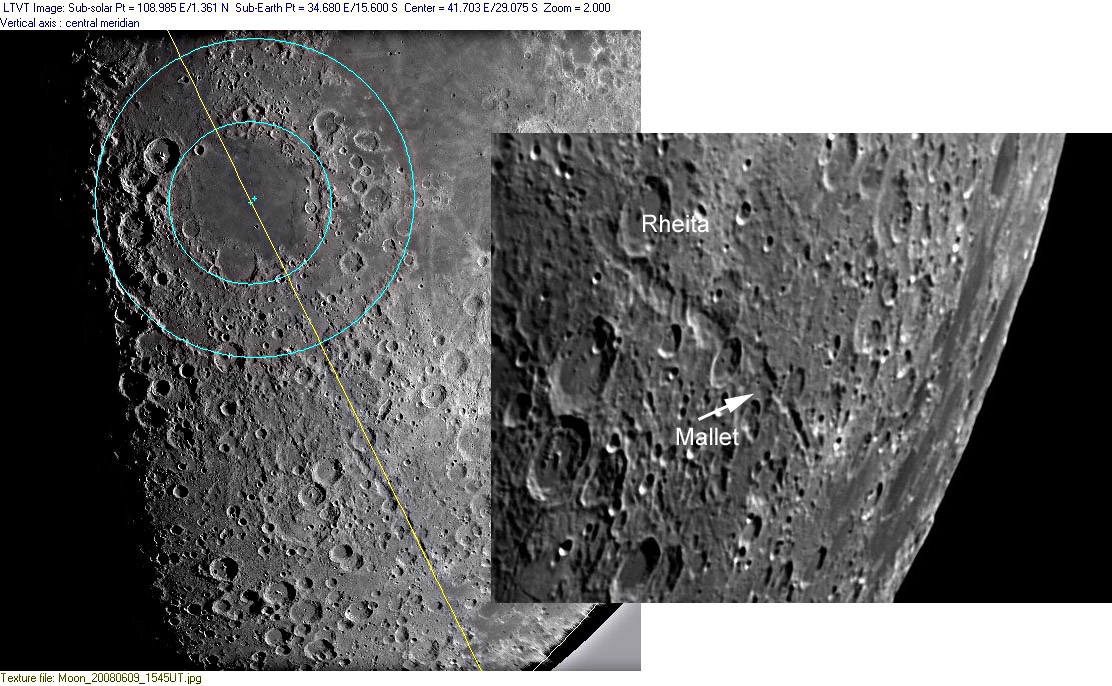January 15, 2018
Straight Talk
Originally published July 23, 2008

right image by Peter Lloyd, Bedfordshire, UK.; left from the Minsk Miracle Imagers, reprojected by Jim Mosher, somewhere in California
Recently Peter Lloyd was imaging the Moon and thinking about what he saw. That is wonderful, because there is always something new to learn when looking carefully at the Moon. Peter had imaged the Rheita Valley under favorable libration and read about it in The Modern Moon (p 105). In the book I quoted Baldwin and Hartmann that the Valley bends near the middle. Peter wondered if the Valley was really straight or if it just looks bent because of our view from Earth. Hartmann pointed out that the more distant part - which he called the Mallet Valley after the crater near the bend - is radial to the center of the Nectaris Basin, and the Rheita Valley is really tangent to the inner basin ring. To confirm this analysis, Jim Mosher used LTVT and an excellent image from imagers in Minsk, Russia to create a view centered on Nectaris. The yellow line passes through the Mallet Valley and also very close to the center on the Nectaris Basin. If you put a straight edge along the Rheita Valley you will see that Hartmann was right about it too - it is tangent to one of the basin's inner rings. Peter wonders why the Rheita Valley isn't radial to Nectaris. Did it - an impact basin secondary crater chain - come from some other basin? The Rheita Valley probably did originate from the formation of Nectaris because that is the nearest basin and there are other nearby radial features such as the Snellius Valley. Scientists don't know enough about huge impact collisions to completely understand all the details. But Nectaris isn't alone in having tangential ejecta - if you trace back the broad rays in Mare Nubium you will see they are tangent to Tycho, not radial. I wish nature paid a little better attention to our theories.
Chuck Wood
Technical Details
How did Hartmann know, back in the 60s, what was radial and what wasn't? In those early computer days he did it optically, projecting a telescopic image onto a white hemisphere and rephotographing right over Nectaris to remove distortions. See p 17 of The Modern Moon for a picture of how it worked.
Peter's image: 9th June 2008 20:41 UT. LX200 at prime focus + Atik 1-HS camera. Capture: K3CCDTools. Low gamma, 1/250", 40% gain, 904 frames. Processing: Registax. 409 frames stacked. Histogram 0-124, wavelets 1-2 = 10.
Minsk image: June 9, 2008, 1545UT. Maksutov-Cassegrain Santel D=230mm F=3000mm, Astronomik Planet IR Pro filter (IR-pass 807nm+), Unibrain Fire-i 702 CCD b/w camera, (IEEE-1394, 1388x1040, 10fps, 12bit), Processing in Registax & Maxim DL. The Minsk imagers are Mikhail Abgarian, Yuri Goryachko, and Konstantin Morozov.
Related Links
Rükl plate 68
Peter's Astrolloyd page.
Yesterday's LPOD: Dark Rays, Dark Streaks
Tomorrow's LPOD: Deviant Tracks
COMMENTS?
Register, Log in, and join in the comments.



